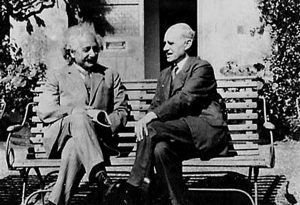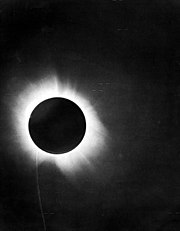The IMUS, with the participation of the Faculty of Mathematics, will be holding a meeting on Wednesday 6 March to celebrate the 100th anniversary of the measurement of the deflection of light by gravity: the first experimentally verified prediction of Einstein’s theory of general relativity.

On 7 November 1919, the London Times published a two-column front-page article under the headline “Revolution in Science. New theory of the universe. Newton’s ideas overthrown”. It covered the meeting that had taken place the previous day between the Royal Society of London and the Royal Astronomical Society, during which the results of measurements of the curvature of light carried out in May of that year during an eclipse of the Sun had been presented. These measurements were supposed to tip the scientific balance either in favour of Newton’s still all-powerful gravitation or in favour of Einstein’s immature general relativity.
It so happens that in July 1914 a first expedition, financed by the Berlin Academy of Sciences, had been launched to measure the deflection of light during an eclipse in the Crimea, which was cut short by the outbreak of the First World War. It was a fortunate circumstance for Einstein, because at that time, with the theory of relativity still under construction, his prediction for the deflection of light was half of what actually existed.
Newton had suggested in his Optics that if light travelled at finite speed and was composed of corpuscles – both of which he had little doubt about – then it must be deflected by large accumulations of matter such as the Sun. He made no estimate of the value of that deflection because he lacked adequate data – on the speed of light, for example. When that data became available, the German mathematician, physicist and astronomer Johann von Soldner made the calculations that Newton could not, and in 1804, just a century after the publication of Optics, he told the world that the bending of light attracted by solar gravity must have been around 85 arcseconds. However, von Soldner’s estimate came somewhat late, as the work of Young and Fresnel was beginning to convince scientists that light was not made up of corpuscles but was a wave and, therefore, was unlikely to be affected by solar gravity. Consequently, von Soldner’s calculations were forgotten. But when Sir Frank W. Dyson (1868-1939), then Astronomer Royal and Director of the Greenwich Observatory, proposed to organise an expedition to observe the solar eclipse of May 1919 and check whether Einstein’s estimates were correct, those who saw such an expedition as a threat to Newton’s gravitation unhesitatingly dusted off von Soldner’s calculations.

The question was even more tricky. First, because if Einstein’s theory were confirmed, it would be to the detriment of Newton’s, one of Britain’s national heroes! And second, because Dyson made his proposal in the middle of the First World War, and what was to be tested was the theory formulated by a German-born scientist, who lived in Berlin and was a member of the Prussian Academy of Sciences: the most prestigious scientific institution of the enemy! –founded, on top of that, at the behest of Leibniz, Newton’s great opponent. Conspiracy buffs would bet on the existence of a black hand behind such a proposal. And there was… only it was not a black hand, but that of Arthur Stanley Eddington (1882-1944) – appointed a Sir in 1930. Eddington was the first British scientist convinced of the superiority of general relativity, about which he published a delightful little book in 1918 and a memorable text in 1923 – Mathematical Theory of Relativity, of which Einstein said: “It is the most successful presentation of the theory that has been written in any language”, and where for many years physicists from all over the world learned the theory of relativity. It was Eddington who convinced Dyson to plan an expedition to observe the 1919 eclipse. Although from different generations, Dyson and Eddington shared more than purely scientific interests; both belonged to religious minorities –Dyson was a Baptist, Eddington a Quaker– and both had studied with almost identical honours at Cambridge – Eddington was then professor of astronomy at Cambridge and director of the University’s observatory. Dyson had, in fact, obtained a wartime dispensation for Eddington on the grounds that he was involved in extremely important scientific work; this was to lead one of the approved expeditions to observe the eclipse of 29 May 1919, if the war allowed it – or if, as someone ironically remarked, “The state of civilisation allowed it when the time came”.
The war ended, and the double British expedition, one to Prince’s Island off the west coast of Africa – led by Eddington – and the other to Sobral in Brazil, was carried out. Not without some cloudy mishap, pictures of the eclipse were taken on 29 May that would allow the curvature of the light coming from some stars in the Hyades cluster in the constellation Taurus –close to the solar corona at the time of the eclipse– to be measured.

The study of the photographs took longer than expected and was not without some controversy –the measurement is extremely delicate as the deviation of light according to Einstein, 1.7 seconds of arc, corresponds to the angle at which a one-euro coin is seen from three kilometres away, or a deviation of 29 hundredths of a millimetre measured in the photographs. Due to clouds, only two of the 16 photographic plates taken on the Prince’s Island were useful, giving a deviation of 1.61 seconds of arc –with an estimated error of no more than 0.3 seconds of arc–; quite in agreement with Einstein’s prediction. At Sobral a larger number of photographs were obtained, but Eddington discarded a part -more in accordance with the deviation predicted by Newton’s gravitation- because presumably the camera lens, exposed to the Sun, underwent a small dilatation that introduced considerable errors in the location of the stars. The plates considered gave a deviation of 1.98 arcseconds – with an error estimate of no more than 0.12 arcseconds.
The data were made public in London on 6 November: there was no room for doubt, the data agreed with Einstein’s predictions. As J.J. Thomson –discoverer of the electron– would write a few years later: “The whole atmosphere of tense interest was exactly that of a Greek drama. We were the chorus commenting on the decree of destiny revealed in the unfolding of a supreme incident. There was a dramatic quality in the performance itself; the traditional ceremonial, and in the background the portrait of Newton to remind us that the greatest of scientific generalisations was now, after more than two centuries, to receive its first modification. The drama of tragedy has its essence not in unhappiness, but in the solemnity of the relentless working of things. This inevitability of fate can only be illustrated in terms of human life… The laws of physics are the decrees of destiny”. The same dramatic atmosphere can be seen in the headline in the Times the following day: “Revolution in science. New theory of the universe. Newton’s ideas overthrown”. And it was Einstein who was the new king to take Newton’s throne. That, moreover, it had been a British expedition that had brought him there was something for which Einstein was grateful at the first opportunity; on 28 November 1919, at the request of the Times, he wrote an article on general relativity that began with these words: “After the regrettable break in the international relations of scientists, this will be the occasion to express my thanks to the English physicists and astronomers. It is in the traditions of their country’s scientific work that celebrated researchers and institutes should devote time and effort to test a theory completed and published during the war in an enemy country. And although it was a purely objective matter when it came to examining the influence of the Sun’s gravitational field on the light beams, I want to express my personal thanks to my English colleagues, for without them I could not have had the verification of the most important consequence of my theory”. Einstein appended a postscript with his finest irony: “I will explain to readers a further application of the theory of relativity: in Germany I am currently described as a ‘German scientist’ and in England as a ‘Swiss Jew’. If it should ever happen that I am presented as a bête noire, then for the Germans I will be a “Swiss Jew” and for the English a “German scientist”.”

The verification that his estimates of the curvature of light were correct turned Einstein overnight into a popular figure, a media star of unusual brilliance: few people before and after Einstein, and certainly no scientist, have been so hunted by the media as he was for the rest of his life. In fact, at the end of the 20th century, Time magazine chose Einstein as the person of the century – followed by Franklin D. Roosevelt and Gandhi.
References
A.J. Durán, El universo sobre nosotros, Crítica, Barcelona, 2015.

Leave a Reply